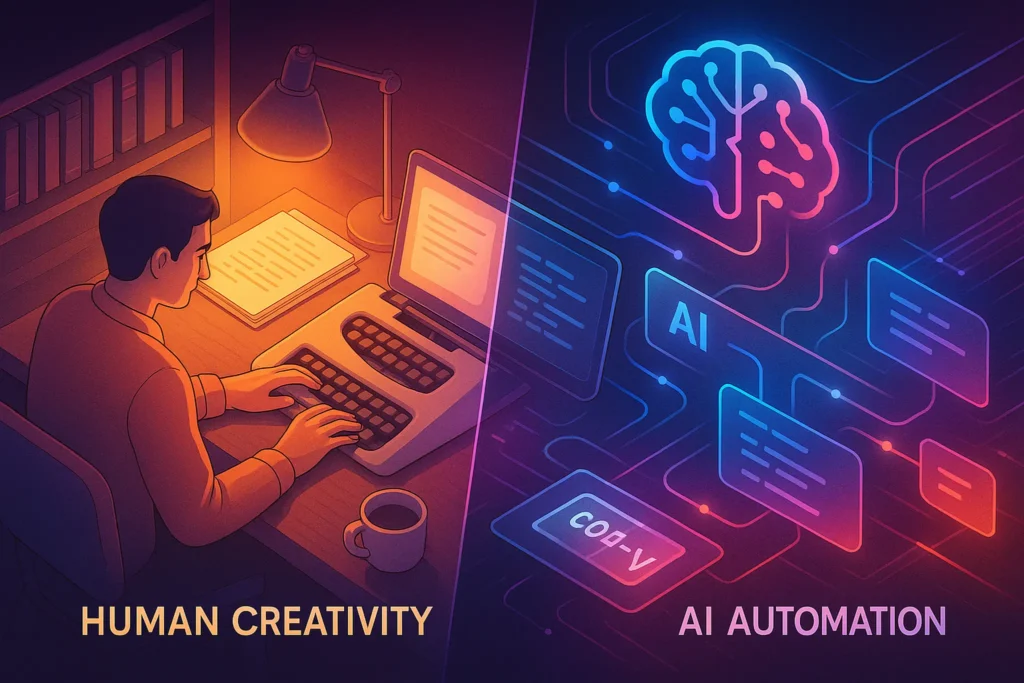-This post may contain affiliate links. If you click on one and make a purchase, I may earn a small commission at no extra cost to you.-
🧭 Introduction: The Remix Debate
In 2025, AI writing tools—from ChatGPT to Jasper—blur the line between human and machine authorship. They can craft polished blog posts, nurture sales copy, even draft scenes. But the million-dollar question remains: Can AI truly create?
This post explores that question—comparing AI’s capabilities with human ingenuity, examining examples of each, and helping you strategically integrate AI into your writing workflow.
We’ll reference current best tools (see Best AI Writing Tools for Bloggers), key AI workflows (Ultimate Guide to Using ChatGPT for Keyword Research), and evaluate psychology, ethics, and the future of authentic content.
🤖 1. What AI Writing Can—and Can’t—Do
AI content generators excel at speed, structure, and consistency—but often stumble on originality.
✅ AI Strengths
-
Efficiency & bulk production: AI can spin out outlines, summaries, and drafts in seconds—no more staring at a blank screen.
-
SEO-ready basics: Platforms like Jasper and GPT‑5 help integrate keyword density, headings, and formatting automatically .
-
Research aggregation: AI tools scan thousands of sources in moments—ideal for fact-checking or trend analysis.
❌ AI Limitations
-
Creativity & originality gap: AI generates from existing patterns. It rarely produces truly novel ideas or unexpected metaphors.
-
Emotional depth missing: Without lived experience, AI struggles to evoke real empathy or craft nuanced narratives.
-
Cultural blind spots: AI tends to homogenize voices towards dominant norms—limiting cultural diversity in tone .
-
Spam & “slop” risk: High-volume AI content can degrade quality, flooding the web with shallow, unengaging posts.
-
Citation errors (“hallucinations”): AI confidently invents facts or quotes if unsupported.
🎨 2. Why Human Creativity Still Wins
🌈 Originality & Authenticity
Humans craft analogies born from lived experience. AI tends to revert to clichés. Your unique voice—shaped by personality, culture, or profession—is irreplaceable.
🧠 Unexpected ideas emerge
Human cognition connects distant dots—something AI’s statistical math can’t replicate.
💬 Emotional resonance
Real-world stories—anchors of emotion—need firsthand experience. AI may mimic, but cannot feel.
A marketer writing product reviews senses subtleties—tone, user feedback, brand values—that AI misses. For example, your honest take on a tool like Jasper or Sudowrite carries conviction.
🌍 Cultural Relevance
AI models rarely catch local idioms, slang, or comedic nuances. But you do—making content resonate better with your audience.
⚖️ Ethical judgment
Humans weigh tone, context, consent—with awareness. AI risks bias, overgeneralization, or copyright issues without guidance .
🔬 3. Research Says: AI + Human = Stronger Together
A recent meta-analysis across 28 studies (8,200+ participants) found:
-
AI-alone wasn’t more creative than humans
-
Humans with AI outperformed humans alone (effect size g = 0.27), but ideational diversity dropped (g = −0.86).
👉 Conclusion: AI can boost productivity—but only when steered by human insight.
🧩 4. Best Use Cases: Win With Hybrid Workflows
⚙️ Outlines & Draft Frameworks
Let AI generate structure, then enrich it with your insights, stories, and examples.
✏️ Headline & Subheading Variations
AI can spin dozens of headlines; you select what captures emotion and clarity.
✍️ SEO & Metadata
AI helps tag, summarize, and keyword-tune—but your job is to ensure tone and authenticity.
🌟 Polishing Copy
Use AI to check grammar, flow, and readability—but insert your unique voice.
🛠️ 5. Tools & Practical Strategies
These are the go-to tools blending speed and quality:
-
ChatGPT + custom prompts: ask for creative rewrite options based on your core message.
-
Jasper AI: great for template-based tasks (ads, emails). Overcome its limits by adding personal anecdotes.
Jasper excels at content outlines, ad copy, and SEO optimization. Its integration with Surfer SEO means it suggests keyword tags and headings aligned to ranking data.
How it helps you:-
Generate 5 headline variations to suit your style
-
Create short social captions from the same blog
-
Automatically recommend internal links
“Want AI that writes in your voice and respects SEO? Try Jasper—I use it daily to draft headlines and content briefs.”
-
-
Sudowrite: built for fiction, it helps find metaphors or character insight.
Built for storytellers and long-form writers, Sudowrite helps with metaphor generation, scene description, and character development.
How it helps you:-
Unblocks writer’s block with creative “twist” suggestions
-
Helps diversify tone and expand narrative when your content feels flat
-
-
Grammarly Premium: refines tone, clarity—humans add cultural relevance afterward.
Once your draft is rich, Grammarly polishes tone, clarity, and emotional engagement with tone detection and suggestions.
How it helps you:-
Ensures active voice and reader-friendly phrasing
-
Checks for consistency across multiple pages/posts
-
-
Copy.ai
A free-to-start assistant that generates blog intros or social post ideas in seconds—ideal for writers seeking variety at zero cost.
How it helps you:-
Drafts punchy opening paragraphs
-
Creates newsletter subject lines and LinkedIn headlines
-
🌟 6. Advanced Workflow: AI-Enhanced Research & Ideation
-
Idea Mining: Use ChatGPT or Copy.ai for topic clusters (e.g., “What do people ask about productivity tools?”).
-
Outline Generation: Run the idea into Jasper, fine-tune with prompt variables (word count, tone).
-
Human-Led Enrichment: Add your own examples (e.g. case studies, personal stories, affiliate tool mentions).
-
Tone & Grammar Polish: Grammarly wraps it up.
-
Optimize Internal Links: Weave in references like Best AI Writing Tools for Bloggers and Ultimate Guide to Using ChatGPT for Keyword Research naturally:
-
Example: “As we explored when discussing AI Writing Tools for Bloggers, Jasper helps streamline headline creation…”
-
This layered process gives you speed, SEO, uniqueness—and a chance to sprinkle affiliate links seamlessly.
🧠 7. Risks & Safeguards When Using AI
AI is powerful—but has pitfalls.
⚠️ Risk: Hallucination
AI may confidently state false stats or quotes. Always fact-check each assertion.
⚠️ Risk: Generic Tone
Run drafts through your voice—inject meta-observations, lived cases, or client research insights.
⚠️ Risk: Ethical & SEO Issues
Avoid publishing AI-generated content without review—it may trigger plagiarism flags or thin-content penalties with Google.
🔍 8. Real-World Example: From AI Draft to Human-Powered Post
Take this paragraph drafted by Jasper on “Time Blocking”:
“Time blocking improves productivity by allocating your focus. Studies show blocked schedules lead to better work output.”
As the writer, you could enrich it:
“A 2024 Airtasker study revealed that employees who time-blocked were 30% more likely to complete their daily priorities. I tried this during a product launch in March—the result? My team hit all milestones one day ahead of schedule.”
This hybrid version marries AI speed with human insight, and displays credibility.
📚 9. Beyond Text: Can AI Compete in Creative Formats Like Video or Poetry?
While most conversations about AI-generated content focus on blog posts and articles, the boundaries are expanding into video scripts, voiceovers, and even poetry.
-
RunwayML and Pika Labs allow creators to input a brief and get AI-generated visuals or animated sequences. But these tools lack narrative coherence unless guided by a human with storytelling expertise.
-
Suno and ElevenLabs are pushing into AI-generated music and voice work—again, good for speed and filler content, but not emotional peaks.
Even AI poetry generators like Verse by Verse mimic form but not heart. They sound elegant but rarely provoke true reaction.
“AI can rhyme. It cannot grieve. It can mimic Shakespeare’s sonnet, but not the sting of betrayal.” – as The Guardian recently noted (source)
That’s the central paradox: AI can speak like us—but not feel like us. For deep storytelling, your personal history, emotional nuance, and reflective awareness are still unmatched.
💼 10. Who Should NOT Fully Rely on AI Writing?
AI is a powerful assistant, but there are specific scenarios where relying too heavily may cause harm or dilute brand credibility:
🚫 Thought Leaders & Personal Brands
Your voice is your signature. Overusing AI may make your posts sound like generic LinkedIn filler. It’s fine to outline or brainstorm with tools like Copy.ai, but your insights must remain central.
🚫 Medical, Legal, Financial Content Creators
Due to hallucination risk and citation uncertainty, industries with compliance needs should always fact-check AI-generated outputs line by line.
🚫 Social Justice, Identity, or Cultural Writing
AI models trained on dominant datasets can inadvertently erase marginalized voices or misunderstand cultural nuance. Here, human experience matters most.
In short: AI should support you, not replace you.
🔥 11. Real-World Hybrid Workflow (With Sample Prompt Strategy)
Let’s walk through a real 5-step content creation example using ChatGPT + Grammarly + Jasper:
🎯 Topic: “How to Start a Newsletter for Your Side Hustle”
Step 1: Prompt ChatGPT
“Write a blog outline for ‘How to Start a Newsletter for Your Side Hustle’ – tone: helpful, modern, for solopreneurs.”
Step 2: Add Personal Layer
You revise outline sections like “Choosing a Platform” and “Frequency Strategy” to reflect your experience with Beehiiv or Substack.
Step 3: Jasper Expansion
You paste your outline into Jasper and use templates for email subject lines, CTA boxes, or content blocks.
Affiliate CTA example:
“I use Beehiiv for my weekly AI newsletter—it’s free to start and scales beautifully. Try it here [Your Link].”
Step 4: Grammarly + Tone
Final pass through Grammarly Premium adjusts tone from robotic to relatable.
Step 5: Publish + Track
Use UTM links inside Jasper CTA blocks to track which affiliate mention drives traffic/conversions.
📣 Bonus Section: Prompts to Spark Creative + Ethical Content
Want to get more emotion, personality, and nuance from AI? Try these prompt starters:
-
“Rewrite this paragraph to include a personal reflection.”
-
“Turn this list of benefits into a first-person customer story.”
-
“What metaphor would connect AI writing to human storytelling?”
-
“Add a counterargument to this point—what might critics say?”
These give your post argument balance, human voice, and content soul—elements essential for long-form trust.
🧠 Nerd Verdict
AI doesn’t replace creativity—it amplifies it when guided by humans. Treat AI as a before-you tool: it drafts. You craft. Use AI for speed, and your brain for soul.
AI is not replacing creativity—it’s enhancing the drafting process. If you can lead with human insight, steer AI thoughtfully, and polish for authenticity, you win on speed, depth, and SEO. AI does the groundwork; you add the soul.
❓ FAQ
Q: Is AI plagiarism?
A: AI synthesizes from massive data but rarely plagiarizes exactly. It can echo fuzzy sources, so review carefully.
Q: Can AI write full blog posts?
A: Yes—but AI lacks real-world insights. Human edits and strategic framing are essential for engagement and credibility.
Q: Will AI replace writers?
A: No—but routine content may go under agency budgets. Specialists, storytellers, and editors will remain in high demand.
Q: How to retain “human-ness”?
A: Always add at least one personal story, data insight, or voice marker per post. That’s non-AI.
Q: Are there copyright issues?
A: Generally safe, but avoid copying identifiable phrasing from AI quotes. Always review.
Q: How much human editing is enough?
A: At least 30%—introduce personal stories, examples, tone, and data to match your brand voice.
💬 Would You Bite?
What part of your content process do you wish AI could handle?
Drop a comment—I’ll share tools, templates, and real workflows tailored to what you create.👇



